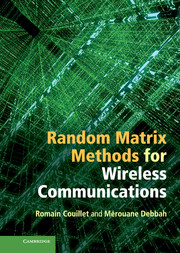Book contents
- Frontmatter
- Contents
- Preface
- Acknowledgments
- Acronyms
- Notation
- 1 Introduction
- Part I Theoretical aspects
- 2 Random matrices
- 3 The Stieltjes transform method
- 4 Free probability theory
- 5 Combinatoric approaches
- 6 Deterministic equivalents
- 7 Spectrum analysis
- 8 Eigen-inference
- 9 Extreme eigenvalues
- 10 Summary and partial conclusions
- Part II Applications to wireless communications
- References
- Index
7 - Spectrum analysis
from Part I - Theoretical aspects
Published online by Cambridge University Press: 07 October 2011
- Frontmatter
- Contents
- Preface
- Acknowledgments
- Acronyms
- Notation
- 1 Introduction
- Part I Theoretical aspects
- 2 Random matrices
- 3 The Stieltjes transform method
- 4 Free probability theory
- 5 Combinatoric approaches
- 6 Deterministic equivalents
- 7 Spectrum analysis
- 8 Eigen-inference
- 9 Extreme eigenvalues
- 10 Summary and partial conclusions
- Part II Applications to wireless communications
- References
- Index
Summary
In this chapter, we further study the spectra of the important random matrix models for wireless communications that are the sample covariance matrix and the information plus noise models. It has already been shown in Chapter 3 that, as the e.s.d. of the population covariance matrix (or of the information matrix) converges, the e.s.d. of the sample covariance matrix (or the information plus noise matrix) converges almost surely. The limiting d.f. can then be fully characterized as a function of the l.s.d. of the population covariance matrix (or of the information matrix). It is however not convenient to invert the problem and to describe the l.s.d. of the population covariance matrix (or of the information matrix) as a function of the l.s.d. of the observed matrices. The answer to this inverse problem is provided in Chapter 8, which however requires some effort to be fully accessible. The development of the tools necessary for the statistical eigen-inference methods of Chapter 8 is one of the motivations of the current chapter.
The starting motivation, initiated by the work of Silverstein and Choi [Silverstein and Choi, 1995], which resulted in the important Theorem 7.4 (accompanied later by an important corollary, due to Mestre [Mestre, 2008a], Theorem 7.5), was to characterize the l.s.d. of the sample covariance matrix in closed-form. Remember that, up to this point, we can only characterize the l.s.d. F of a sample covariance matrix through the expression of its Stieltjes transform, as the unique solution mF(z) of some fixed-point equation for all z ∈ ℂ\ℝ+.
- Type
- Chapter
- Information
- Random Matrix Methods for Wireless Communications , pp. 179 - 198Publisher: Cambridge University PressPrint publication year: 2011



